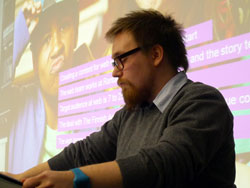The 2012 EBU Production Technology Seminar opened today with keynote speaker Roberto Pomari of RSI setting out his vision for “tomorrow’s broadcaster” and asking delegates to consider whether their organisation is in shape for the challenges ahead. In a changing media world, he said, success will be based on “consolidation of common services, simplification of enterprise infrastructure, automation of business processes and shared services, and integration with legacy systems”.
 |  | |
| Roberto Pomari (RSI) and Samu Reijonen (YLE) at PTS 2012 | ||
A set of four case studies provided examples of some of the wider issues facing broadcasters @transition. With tri-media production being one way of delivering the kind of efficiencies referred to by Roberto Pomari, the presentation of Samu Reijonen (YLE) was particularly timely in providing a real world example. Uusi Päivä seamlessly incorporates the production of content for the web and social networks into the production of the TV show itself. Other case studies included the experiences of French broadcasters with producing live sporting events in 3D and the challenges faced by colleagues in the UK to cover last year’s royal wedding.
After a morning of general presentations it was time to dive into more technical detail, specifically relating to video codecs and file formats. Three informative presentations on the testing of video codecs were followed by a lively introduction to MXF standards from Brad Gilmer of the AMWA. He introduced a vision of where media applications can run virtually in the cloud with real distributed production and editiing applications; and he ended with the question of when will this vision will become real?
The afternoon was brought to a close with presentations on two other interesting file formats, namely the new standards for file-based programme delivery developed by the UK Digital Production Partnership (DPP) and the EBU’s new Subtitling Format specification, EBU-TT.
